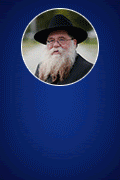
Oak Park Rabbi with a Mission
Rabbi Yitzchok Bergstein insists he is not a missionary, but he is definitely a man with a mission: “To give every Jew the ability to celebrate Judaism.”
Bergstein, who moved to Oak Park in 2008 with his wife Nechama Dina and their family, is a “schliach” or emissary from the Chabad-Lubavitch movement, based in Crown Heights, N.Y. He said his goal is not to start a fifth Jewish faith community in the Oak Park-River Forest area but to “make Judaism come alive for whoever attends our programs.”
There is a certain urgency to the Chabad rabbi’s mission, which he explained from a historical perspective. Many Jewish immigrants to the U.S. who escaped the Holocaust believed that the way to survive as Jews in this country was to assimilate into American culture. Unfortunately, Bergstein added, many immigrants assimilated so well that their children and grandchildren lost much of their identity as Jews.
That is what motivates Bergstein and the over 4,000 Chabad Schluchim posted around the world. “The only way to keep Judaism alive,” he said, “is to reach out to others and teach others.”
This Lubavitcher rabbi with the long beard and who wears a black Borsalino fedora, a black kapota coat and a Tallit Kattan with fringes when he is leading Shabbat prayers has to be able to function in two worlds in order to carry out this mission to his fellow Jews.
Sue Fishkoff in her book, The Rebbe’s Army, writes, “Here are Jews who live according to the strictest interpretation of Jewish law, who adhere to rigid lifestyle constraints, who don’t watch TV or go to the movies or read popular literature, who have little or no secular education … but who nevertheless have made it their mission to engage the modern world.” (p. 27)
One world, the world in which Lubavitchers feel most comfortable, is where Orthodox Jews live in strict adherence to Jewish law — all 613 of them. It’s a world that could come straight out of a Chaim Potok novel or Fiddler on the Roof.
“Chabad kept to the old fashioned traditions and the lifestyle of the schtetl [Eastern European village],” Bergstein said. All of this is done for the purpose of maintaining an environment conducive to the nurturing of an authentically Jewish lifestyle.
In their Shabbat prayer service, for example, the women sit separated from the men and have no part in leading the worship. Most of the prayers are spoken in Hebrew. They read the Bible as being literally true, and, according to Fishkoff, they believe that all human knowledge can be derived from the Torah, including science. Rabbi Bergstein met Nechama through a matchmaker and the couple was married a few weeks later. They have 10 children and are scrupulous in keeping a kosher home.
What is perhaps most striking about Schluchim is their reverence for the person they refer to as the “rebbe.” The role of the rebbe is teacher, advisor, administrator and charismatic leader of the Lubavitch branch of Hasidic Judaism. The first rebbe, Schneur Zalman of Liadi, died in 1812.
Although the seventh and last rebbe, Menachem Mendel Schneerson, died in 1994, Schluchim talk about him as still being with them. Thousands of miracles have been attributed to him, and when the rebbe was alive, Schluchim would happily go wherever he would assign them. Even in death, his influence on Lubavitchers is huge. “The life we live and the concern we have for every Jewish person is something we learn from the life of the rebbe,” said Bergstein.
Some would go so far as to claim that he was the messiah. His impact while he was alive was that great. Bergstein is more cautious in his assessment of the last rebbe.
“Do I think he had the qualifications that have been ascribed to the messiah?” Bergstein asks. “Yes. He was the epitome of a Jewish leader and had qualities Judaism hadn’t seen in many generations. As to whether he was the messiah or not, that’s not for me to answer.”
The other world which Schluchim like Bergstein visit daily is where Jews of widely varying degrees of observance live. Merrill Weber, who attends Shabbat prayer regularly at the Chabad Center and was instrumental in bringing Bergstein to Oak Park, says, “I appreciate the fact that everything is done according to the rules as they have been brought down through Jewish tradition, but [the Chabad Center] is very much a part of the world. I appreciate the non-judgmental way people are welcomed into the Chabad synagogue; people who come to Chabad programming aren’t ranked by levels of Jewish religious observance; everyone who comes is accepted as he is, and if he wants to participate, he is welcome to do as much as he wishes.”
Medical student Joshua Mendoza Elias was attracted “because Chabad tries to keep traditions in a world that’s always trying to simplify and make everything super-convenient. After a while, you’re not left with religion but entertainment.”
How can Bergstein and his family be so strictly observant themselves yet remain so accepting of Jews who are not?
“Every Jew is important to God no matter their level of observance,” he explained. “We are not able to judge or know the greatness of one soul over another. Just because I’m observant and learned does not make me any better a Jew than anyone else.”
Weber describes what he has learned from Bergstein as a “relentlessly comforting philosophy that has changed my entire approach to my own life experiences.” He admits that for Jews who are trying to get back in touch with their religious identity and practice, entering an orthodox synagogue can be intimidating.
“There is a fear of being judged and a fear of committing a faux pas that would identify the person as a poser or somehow inauthentic,” he explained. “People have to understand that Chabad is very much a part of the modern world, and that our rabbi, just like all Chabad rabbis, understands that many people have a strong desire to connect to the Judaism of their ancestors but don’t have any idea how to get there.”
An ideal example of a Chabad program is the annual seder, which was held in the basement of Rabbi Bergstein’s home on the first evening of Passover, April 18.
At the head of a horseshoe shaped arrangement of tables were Bergstein and four of his sons. Around the sides of the table were seated his father-in-law and mother-in-law, his wife and those of his children who weren’t already tucked in bed.
In addition to his family, 20 guests participated, including two men dressed like their rabbi in black fedoras and kapotas. Three or four young men wore yarmulkes. One older man, a member of West Suburban Temple Har Zion, wore a baseball cap. Two of the women present are in graduate school, studying to be physicians’ assistants. One man was Catholic and another was Lutheran. The frequency of attendance at Shabbat prayers and the degree of observance among the guests varied greatly.
Since most of the members of Chabad synagogue were having their seder meals in their own homes, many of the guests present were exploring the meaning of this important Jewish ritual. Bergstein therefore prefaced most of the Hebrew prayers and the ritual actions of the seder with explanations in English of the meaning of each step in the meal.
He especially emphasized that the story told through the medium of the Passover meal was a narrative of liberation that not only described the freeing of the Hebrew slaves from Pharaoh’s Egypt 3,000 years ago but also provided every participant the opportunity to live the story and experience God’s power to free people from the restrictions in their lives which hold them in bondage.
The work done by the Chabad Schluchim has many critics as well as supporters. Victor Mirelman, rabbi emeritus of the conservative West Suburban Temple Har Zion in River Forest, says that, on the one hand, the views of the Lubavitchers are controversial among their fellow Jews. He said they have come under criticism for the position to which they relegate women, their position on Zionism, their messianic views and the perception that they are competing with existing synagogues and Jewish schools.
On the other hand, said Mirelman, “Chabad has its strengths. It challenges the establishment. It also attracts people drawn to a more mystical individual experience and more traditional ways of doing things.”
When asked about the many criticisms leveled against Chabad, Bergstein sighed and said, “The establishment of this Chabad center is to serve the needs of all Jews, to be an open door for those searching in Judaism with a great emphasis on the unaffiliated. We don’t picture ourselves as competition.”




















bubby kahanov
Proud tq be related to such sincere shluchim!!!!!!
HATZLACHA MUFLAGAH!!!!!!
Milhouse
You should identify which Oak Park this is. There are Oak Parks in California, Illinoi, and Michigan, each with shluchim! This is Oak Park IL, and I recently heard a very good report from a friend who went back there to visit his ailing mother. The shliach was very helpful, and even offered to send someone to his mother’s house on Purim to read the megillah for her. Meanwhile her own Conservative “rabbi”, of whose “shul” she has been a member longer than the “rabbi” has been alive, didn’t even bother visiting her once. My friend was very impressed with the ahavas yisroel shown for a yid who is not Orthodox and is not likely to ever be a member of his Chabad House, just because she’s a bas Avrohom Yitzchok Veyaakov. Yasher koach on making a true kiddush Hashem and kiddush Lubavitch.